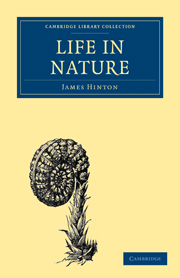Book contents
- Frontmatter
- Contents
- INTRODUCTION
- CHAPTER I OF FUNCTION; OR, HOW WE ACT
- CHAPTER II OF NUTRITION; OR, WHY WE GROW
- CHAPTER III OF NUTRITION; THE VITAL FORCE
- CHAPTER IV OF LIVING FORMS; OR, MORPHOLOGY
- CHAPTER V OF LIVING FORMS; THE LAW OF FORM
- CHAPTER VI IS LIFE: UNIVERSAL?
- CHAPTER VII THE LIVING WORLD
- CHAPTER VIII NATURE AND MAN
- CHAPTER IX THE PHENOMENAL AND THE TRUE
- CHAPTER X FORCE
- CHAPTER XI THE ORGANIC AND THE INORGANIC
- CHAPTER XII THE LIFE OF MAN
- CHAPTER XIII CONCLUSION
- APPENDIX: AN ATTEMPT TOWARDS A MORE EXTENDED INDUCTION OF THE LAWS OF LIFE
CHAPTER III - OF NUTRITION; THE VITAL FORCE
Published online by Cambridge University Press: 29 August 2010
- Frontmatter
- Contents
- INTRODUCTION
- CHAPTER I OF FUNCTION; OR, HOW WE ACT
- CHAPTER II OF NUTRITION; OR, WHY WE GROW
- CHAPTER III OF NUTRITION; THE VITAL FORCE
- CHAPTER IV OF LIVING FORMS; OR, MORPHOLOGY
- CHAPTER V OF LIVING FORMS; THE LAW OF FORM
- CHAPTER VI IS LIFE: UNIVERSAL?
- CHAPTER VII THE LIVING WORLD
- CHAPTER VIII NATURE AND MAN
- CHAPTER IX THE PHENOMENAL AND THE TRUE
- CHAPTER X FORCE
- CHAPTER XI THE ORGANIC AND THE INORGANIC
- CHAPTER XII THE LIFE OF MAN
- CHAPTER XIII CONCLUSION
- APPENDIX: AN ATTEMPT TOWARDS A MORE EXTENDED INDUCTION OF THE LAWS OF LIFE
Summary
Thus we have clearly before us the idea of the organic state as one of tension, dependent upon an opposition to chemical affinities. And we see, too, how this tension is produced, at least in some cases: namely, by the previous operation of those very affinities themselves. But some interesting questions suggest themselves here, to which it is in our power to give at least probable answers. We may ask whether this dependence of the living state on chemical action is universal; or whether other forces, such as light and heat, may not also directly produce it? There appears reason to believe that the latter is not the case; but that a process of chemical change is always connected with the vitalizing of matter, and that any other forces which contribute to this end do so by first exciting chemical activity. Where the latter is not present, no amount of other force suffices to induce the vitalizing process. And so far from these other forces being always absorbed when growth is in progress, we see a notable instance of the contrary in the germination of the seed, which is attended with a decided rise of temperature. It appears that here the amount of chemical change is in excess of the vital action consequent upon it, and that, therefore, while a part of the force it generates goes to reproduce the vital state, and bring about the growth of the young plant, part of it passes off as heat.
- Type
- Chapter
- Information
- Life in Nature , pp. 59 - 73Publisher: Cambridge University PressPrint publication year: 2009First published in: 1862

